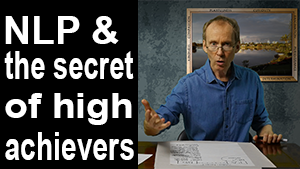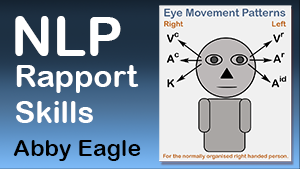
Learn how to improve your learning strategies and get higher grades at School and University using NLP... Phone 07 5562 5718 or send an email to book a free 20 minute telephone or Skype session. NLP Coaching, Hypnotherapy and Meditation. Gold Coast, Robina, Australia. Online NLP Coaching sessions on Skype or over the phone also available.
How to work with an Auditory Processing Disorder using NLP?
In other words, how to get better grades at School and University.
What are visual and auditory processing disorders?
Visual processing disorder refers to the difficulty in making sense of information taken in through the eyes. Auditory processing disorder is a term that covers a range of problems that basically seem to describe the difficulty in hearing and processing of verbal instructions. For example:
- Finding it difficult to concentrate in noisy environments.
- Difficulty in following verbal instructions.
- Reading, writing, spelling, dyslexia and other speech-language difficulties.
- Difficulties in understanding abstract words and concepts.
- Difficulty in following conversations.
For example, the child may have difficulty following verbal instructions. For example the teacher says, “Get your history book out, go to page 24 and start at section 3. But the child only goes as far as getting out their book and then has to look and see what other children are doing.
Identify representational systems
We start by building an understanding of representational systems and eye movements. Eye movements are reliable indicators of the representational system being used by the person you are observing. The map below illustrates the direction in which the eyes tend to move when the person is accessing that system.

Normally organised right handed person refers to the dominant brain hemisphere being the left hemisphere and the person being right handed. Those people who are organised differently may access memories by moving the eyes to the right rather than the left, and construct thoughts by moving the eyes to the left.
Practise focussed peripheral sensing
If the person has difficulty in focussing their attention and is easily distracted by things in their environment then it may be useful to teach them how to work with peripheral sensing. In focussed sensing we bring our attention to whatever it is that we want to focus on in either the visual, auditory, kinaesthetic, olfactory or gustatory sense. In peripheral sensing we learn to be receptive to information that is in the peripheral field. Focussed peripheral sensing utilises both focussed and peripheral sensing and helps us to access both left and right brain hemispheres.
However before we can attend to something we have to set an intention to do so. Once the intention is set then we learn to attend to whatever is important to us. So attention starts with intention. Part of setting an intention is to set the frame for the topic and then chunk down to specific details.
In this digital age every student should learn to touch type
Learn to touch type, so that you are able to look at the screen and pay attention to visual stimuli while your hands type the keys. This will link the visual and kinaesthetic systems in the brain. It also develops the ability to concentrate.
Learn to spell like a champion using the NLP spelling strategy
Even though spelling is a visual process it is generally taught phonetically but when you think about it you can’t even spell the word ‘phonetically’ phonetically. Sounding out words may cause confusion of meaning as well as misspelling. For example, if you sound out the word, 'disappear' and then have it remind you of an ear or a pear then it takes you away from the actual meaning of the word itself.
The NLP simplified spelling strategy is as follows:
- Get the correct spelling for the word and write it down. Look at the word and make an image of it in your mind.
- Physically look up and in your imagination paint the word on a wall or on the ceiling. Don't talk to yourself as you do this, just imagine yourself painting the word in big, bright, colourful letters.
- Bring your eyes back down in front of you then look back up to where you painted the image and just copy the word down onto a piece of paper. Don't talk to yourself as you do this, just silently copy the word down, letter by letter.
- Now compare the word that you wrote down with the image in your mind. Are they the same? Check the spelling against the dictionary spelling (step 1.).
- If the words match then feel good, if not then feel uncomfortable and repeat the process until you get the word right.
- Make it a habit to always correct words as soon as you recognise a misspelling.
Build a rich internal representation in all the senses and link the elements
Link the incoming information in all representational systems. To practise start by making an image of a cat. Then put an image of a dog on the cat. Then put an image of a bird on the dog.
Build a rich internal visual representation. What type of cat is it? How big is it? What colour? What type of fur? Any distinctive markings? How old? What sex? Repeat the procedure with the dog and the bird. Are the images still or moving? If they are still then bring in some action. Get the images moving in your mind to create a film.
Next tune into the auditory representation. As you think about what the cat looks like ask yourself what does it sound like? Some people may get an auditory digital representation of the sound rather than the actual sound itself. Tune into the actual sound of the cat. Ask questions to prompt the unconscious mind. What is the volume, tonality and tempo of the sound? Repeat the process tuning into the sounds of the dog and the bird.
Next develop a tactile representation of the animals? What does it feel like to stroke the cat and the dog, what would the bird feel like if it was in the palm of your hands? What would its feet feel like on your hands? What are your feelings about the cat, dog and bird?
Once you have built and enriched the internal representation you need to learn how to retrieve the information. Use visual predicates to retrieve visual information. For example, "What colour is the cat's fur?" Where the word colour presupposes use of the visual sense. To retrieve information in the auditory sense you auditory predicates such as, "What does the dog sound like if the bird lands on its back?" Ask a range of open ended questions rather than closed questions which can be answered with a 'yes' or 'no'.
For example, "Are there two animals and a bird.", is a yes no answer. To encourage a more active process in the retrieval ask, "How many animals are there?" If the person sorts for sameness the answer will probably be ‘3’ but if the person sorts for difference the answer may be ‘2’ as a bird is not normally classed as an animal, though at a higher level of abstraction it is. Ask questions that stimulate the thought process like, "What colour is the cat? What is the relationship between the dog and the bird? What does the dog do when the cat meows?"
How to remember abstract words?
Words that denote things like cat, dog and bird are easy to remember because they exist in real life but what about abstract words like 'have'? If you were asked to memorise a list of the following words how would you do it?
- Have.
- Have not.
- Haven't
The first step is to create a mental picture of the word. Second step build an internal representation in pictures, sounds and feelings by exploring the meaning and use of the word in the English language.
Start with something that you already have, like a pair of black shoes then ask yourself questions like, "Have I got a pair of black shoes? Then ask a question about something that you don't have, like, "Have I got a pair of red shoes?" Your answers will be something like, "I have a pair of black shoes and I don't have a pair of red shoes."
Contrast the thought process of having a pair of black shoes, and not having a pair of red shoes. What it is like having a pair of black shoes and not having a pair of red shoes? How do the images in your mind change? In there a difference in how you talk to yourself about having and not having? What is the difference in feeling?
Map out the thoughts in your mind
We use the practice of mind mapping to explore how thoughts, ideas and concepts interrelate with each other. Take a central topic such as your last holiday and map it out on paper building in a rich internal representation in all senses. In the centre of the page write the word 'holiday' then around that keyword write headings for anything that was associated with the holiday. Such as the names of the towns that you visited. Then under each of the towns list the places that you visited. For each place list the items that you want to remember.
For each heading, subheading and item draw a picture. Draw lines with arrow heads that connect different part of the map together then map a note on the side of the line for why one item connects to the next. Print the words clearly, use colour where appropriate and use flourishing actions when you join the items with a line. Build a rich internal representation in all the senses. What could see, hear, feel, smell and taste? How do you know that you have a memory of arriving at your destination? How do you know that you left? Are your visual memories still pictures or moving? Are they in colour or black and white? Can you remember what you heard at the time, the sounds that were their, the sound of your own voice? Can you remember what you could touch? Can you remember how you felt at the time? Can you remember any smells or tastes?
Connect each element in the memory with pictures, sounds and feelings by contrasting the memories, for example. What was the difference in the food at difference restaurants? What was the same? Did you meet anyone with an unusual accent? What was familiar to you on the holiday? What was different? What will you never forget? How specifically was life different for you when you got back home? What did you learn from the holiday? How was this holiday different to other holidays? How was the holiday similar and different to your everyday life? Where would you like to go on your next holiday? Use this same type of process to remember and retrieve any type of information.

But how to retrieve the information?
Once you have connected all the elements together in all senses you need to have multiple ways of re-accessing the information. We re-access information by asking questions. Ask questions of yourself and of others to stimulate your memory. The more questions that you ask then the more likely you will be able to remember the information.
Sorting styles: Sameness / Difference Metaprogram
To get good grades in the education system you need to sort for sameness such that you can follow instructions and give the answer that the teacher wants. To explore the sameness difference Meta Program we ask questions about the relationship between two or more things. For example, "What is the relationship between three pens?" One answer could be that, they are all the same, while another answer could be that one is black, and two are blue, but one of the blue and the black pens are full of ink while one of the blue pens is empty. In the first answer the person is sorting for sameness while in the second they are sorting for difference.
Likewise what is the relationship between a PC desktop computer, an Apple Mac laptop and a Samsung Tablet? If you sort for sameness then they are all computers but if you sort more for difference then you will find many differences. What do you typically sort for? Sameness or difference? Sorting for difference is a sign of creativity while sorting for sameness is a sign of being able to follow instructions and gain agreement with others. In a learning situation we need the flexibility to think the same way the teacher thinks.
Enrich your understandings of difficult words
Some people cannot move forwards until they understand a single word. For example, a child may be asked to write a narrative but may not understand what the word 'narrative' means. Give yourself permission to ask questions. If you don’t know what the word 'narrative' means then ask a number of people what their understanding of the word is? One person may say it means to tell a story, another person says just go and write your story, another person says a narrative is like a story book. What do you think the word 'narrative' means? Check the dictionary. Get multiple ways of understanding the word. Build an internal representation in pictures, sounds and feelings. (and smell and taste) By internal representation we mean the cinema of the mind.
The use of nominalisations rather than process words may make the communication challenging for some people. Nominalisations are process words (verbs) that have been frozen in time making them a noun. Whereas verbs often refer to action, nouns refer to static things. For example in the sentence, "There is a lack of communication.", 'communication' is an abstract noun, a nominalisation. The only way to understand the sentence is to ask questions like, "Who is not communicating what to whom? How specifically is there a lack of communication? How specifically would you like to communicate? What words, tonality, tempo, volume, body language, etc."
Since we can't change the way another person talks then we have to learn how to understand what they mean by gathering information until we do so. We do this by asking NLP Meta Model questions such as, "What specifically do you mean by that word?"
Processing verbal instructions
Now we come back to the verbal instructions given by the teacher at the beginning of this article. "Get your history book out, go to page 24 and start at section 3."
First we need to learn to segment the day into activities. That is we give activities an arbitrary beginning and an end. For example, the first segment of the day may in getting out of bed and getting ready for breakfast. The next segment may be having breakfast, travelling to school or work and so on. School lessons may be segmented into 40 minute periods. Then within that forty minutes there may be a short period for role call, then an overview of the lesson, then an activity, a discussion segment, and then a review of the lesson, homework activities and then a good bye. Segmenting activities makes it easier to understand the task at hand; it also makes it easier to recall at a later date. Personally I like to segment the day into 10 minute sections.
In a classroom situation the teacher may or may not clearly mark out each segment, so the onus is on the student to learn to listen to words given by the teacher that indicate the beginning of an activity. The teacher may give an overview of the activity then hopefully write the steps on a white board. The teacher may say something like, "And now we are going to do an exercise," or "What I want you to is," or "The task is to do," or "Please turn to page 24."
Listen for keyword phrases that indicate the beginning of an activity. Tune into what the teacher said. Repeat what the teacher said in your mind and and immediately write it down in a way that makes sense to you. When the teacher gives verbal instructions the words follow each other in a sequence. "Get your history book out, go to page 24 and start at section 3." We take that sequence and write it in a visual form much like a recipe as follows.
- Get your history book out.
- Go to page 24.
- Start at section 3.
By writing down on paper what you think you heard the teacher say you map across from the auditory to the visual channel. You also access your kinaesthetics with the action of writing. If necessary get clarification by asking the teacher if you have the correct steps? Ask, "So you want us to get our history books out, go to page 24 and start at section 3, is that right?" At times you may need to check with others if you have the correct steps.
The education system basically caters for a narrow range of learning styles. Those children who process information differently to their teachers may fall by the way side, but take heart for Einstein was considered to be learning disabled and look what happened to him. If you are looking for an NLP Coach then feel free to contact me using the contact form on this page.
Share With Friends
| DISCUSSION GROUPS | |
|---|---|
 |
|
| NLP Future Selfing | |
| NLP, Hypnotherapy & Meditation | |
| NLP Peace Mapping | |
| Facebook Discussion Group | |











